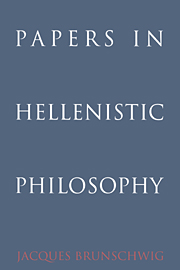Book contents
- Frontmatter
- Contents
- Acknowledgements
- Preface
- I EPICUREANISM
- II STOICISM
- 3 Remarks on the Stoic Theory of the proper noun
- 4 Remarks on the classification of simple propositions in Hellenistic logics
- 5 The conjunctive model
- 6 The Stoic theory of the supreme genus and Platonic ontology
- 7 On a Stoic way of not being
- 8 Did Diogenes of Babylon invent the Ontological Arugument?
- III SCEPTICISM
- Bibliography
- Index of subjects
- Index of names
- Index of passages cited
7 - On a Stoic way of not being
Published online by Cambridge University Press: 25 October 2009
- Frontmatter
- Contents
- Acknowledgements
- Preface
- I EPICUREANISM
- II STOICISM
- 3 Remarks on the Stoic Theory of the proper noun
- 4 Remarks on the classification of simple propositions in Hellenistic logics
- 5 The conjunctive model
- 6 The Stoic theory of the supreme genus and Platonic ontology
- 7 On a Stoic way of not being
- 8 Did Diogenes of Babylon invent the Ontological Arugument?
- III SCEPTICISM
- Bibliography
- Index of subjects
- Index of names
- Index of passages cited
Summary
There are many Stoic ways of not being, or – to be more precise – of not being a ‘being’ (őν). The only one with which I shall be concerned here is that which consists in being the intentional object of an impulse (ὁρμή), or of some kind or other or a sub-kind of impulse (őρ∈ξις, tendency; ἐπιθμία, desire; βού λησις, will; aρ∈σις, choice, etc.). The technical formulation of this aspect of Stoic ‘meontology’ can be summed up in three statements: (i) impulses are directed towards (ἐπί) predicates (κatηγορήμaVa); (ii) predicates are incorporeals (as, in general, are the λ∈κτά, of which they are a species); (iii) incorporeals are not beings, for only bodies are beings. Statement (i) is to be found in particular in the Ti text (see Appendix to this chapter). I shall henceforth refer to it as the POI thesis (it is a Predicate that is the Object of an Impulse). Statements (ii) and (iii) crop up all over the place.
To explain my choice, let me take as my starting point two extracts from Long and Sedley's splendid work (1987). On the one hand, they note in their bibliography (vol. II, p. 498) that ‘there has been much interest in the thesis that the object of a practical impulse is a predicate’.
- Type
- Chapter
- Information
- Papers in Hellenistic Philosophy , pp. 158 - 169Publisher: Cambridge University PressPrint publication year: 1994
- 1
- Cited by



